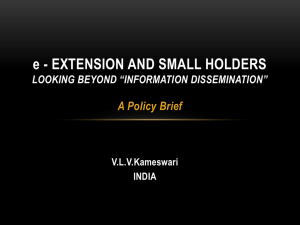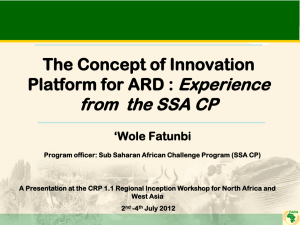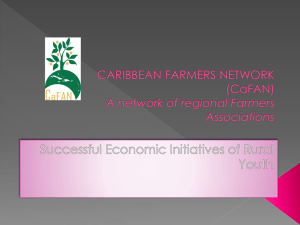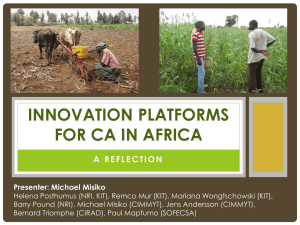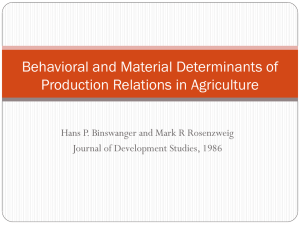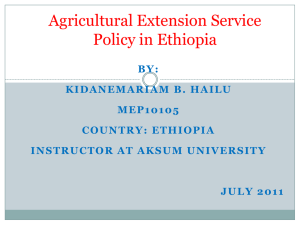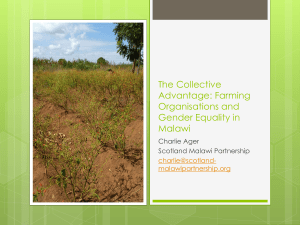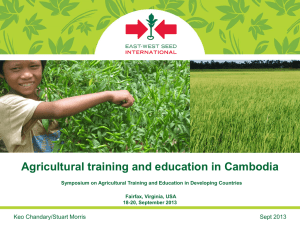PowerPoint
advertisement
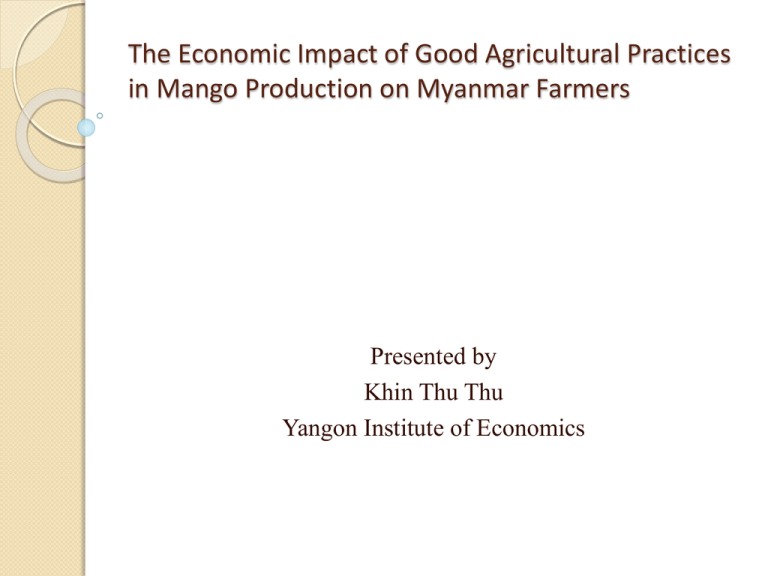
The Economic Impact of Good Agricultural Practices in Mango Production on Myanmar Farmers Presented by Khin Thu Thu Yangon Institute of Economics Rationale of the Study Today , the challenges for development become sustainable environment, food security, food safety and sustainable agriculture. All these issues call for appropriate policies, regulations and implementation of the policy makers. Agriculture is expected to assure food security now and in the future, is increasingly called upon to produce positive environmental, social and economic benefits. Agriculture is a key contributor to meet these challenges and therefore, the paradigm is dramatically shifting for its primary producer or farmers to be harmony with new market demand for safety and quality food. The farmers also become key role players for all challenges and participation of farmers is required for all development initiatives. Basic Concept of Rationale Sustainable environmental issue Sustainable Agriculture Worker Safety To Adopt Suitable Agricultural Methods Farmers need to change their traditional methods to suitable agricultural methods Food Quality and Safety All developing countries which mainly depend on agriculture sector to earn foreign exchanges, face with changing international food markets and proliferation of standards and cods. With the expanding globalization trade, the market demand for safe and quality food become increased. To response the increased demand, each country tries to participate in the global market and adopts suitable agricultural methods to upgrade the quality and safety of food. Agriculture producers also face with changing their traditional methods to new methods. ( Whether they adopt the new methods or not) Good Agricultural Practices (GAP) is formulated to designate codes of agricultural production for safety and quality food. GAPs rely on these principles: a) Economically and efficiently produce sufficient, safe and nutritious food; b) Sustain and enhance natural resources; c) Maintain viable farming enterprises and contribute to sustainable livelihoods; d) Upgrade the welfare of the workers. Public and private stakeholders need to work together for GAP implementation . In Myanmar, agriculture sector has long been crucial and other sectors of the economy is interrelated with agriculture sector directly or indirectly. Series of government designated agriculture as the main pillar of the economy and also focused on agriculture sector to increase foreign exchange earnings by exporting agro-products. Myanmar government also lunched GAP to the farmers and Myanmar GAP is based on ASEAN guideline GAP. According to the current situation, GAP has not yet successfully implemented all around the country, but some farmers and large farm owners are now adopting GAP for fruits production, especially in Mango. This study will be emphasized to know the current conditions and government measures on the development and promotion of Good Agricultural Practices in Myanmar. It will also focused on finding the constraints and benefits of farmers who are adopting GAP. Objectives of the Study To know the government’s measures on the development and promotion of Good Agricultural Practices in Myanmar To identify the constraints in adopting GAP in Myanmar To know whether GAP provides benefits to the farmer or not Research Questions Four research questions came out for this study How is the government promoting the development of Good Agricultural Practices? What are the constraints for adapting GAP in Myanmar? What are the benefits of farmers who are adopting GAP? Will GAP be developed in the Future? Research Methodology This study will be used both qualitative and quantitative research methodologies based on both primary and secondary data . The secondary data will be collected from the respective government offices and departments. Published data, and statistics will also be used for secondary data collection. For primary data collection, in-depth interviews and focused group discussion will be made for both GAP adopting farmers and GAP non-adopting farmers. Literature Review The Role of GAP in Development World agriculture in the twenty-first century is faced with three main challenges: 1) To improve food security, rural livelihoods and income; 2) to satisfy the increasing and diversified demands for safe food and other products; and, 3) to conserve and protect natural resources. These challenges have been articulated by the international community through the World Food Summit Plan of Action and the Millennium Development Goals with specific targets to be met by 2015. (FAO) The Implementation of GAP in Developing Countries ( Countries’ examples) The Concept of Economic Impact Economic impact analysis (EIA) examines the effect of a policy, program, project, activity or event on the economy of a given area. Economic impact is usually measured in terms of changes in output or value added and associated changes in jobs (employment) and income (wages). Generally, the economic impact measurement is mainly based on the following areas: (1) employment levels (jobs) (2) value added (or gross regional product) (3) aggregate wages and salaries (4) wealth (including property values) (5) business output (sales volume or spending). Each of these measures reflects a particular dimension of improvement in the economic well-being of area residents, Conceptual Framework of the Study Implementation Capacity building Quality of extension service Quality of training materials Training follow up action What level of GAP contents included Environment Food Safety Produce Quality Worker safety, Wealth fare and health Level of people participation Findings and Suggestions Farmers application on GAP Output Application of GAP in Mango production Economic gains by farmers in terms of net income, employment, wealth (property) Constraints and Opportunities Comparing with Farmers who are not adopting GAP in the same indicators

